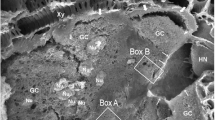Summary
The occurrence and position of wall protuberances in giant cells induced in coleus roots by the root-knot nematodeMeloidogyne arenaria is described, and the structure and function of giant cells is compared with that of syncytia induced by cyst-nematodes.
Extensive protuberance development occurs on walls of giant cells adjacent to xylem vessels. Protuberances are less well developed next to sieve elements, and almost absent next to parenchyma cells. On walls between giant cells they occur on both sides or only one side. The formation of protuberances indicates that giant cells are multinucleate transfer cells. The position of protuberances marks the wall area where solutes enter the cell. Solutes are obtained from xylem and phloem elements, and the position of protuberances at the junction between giant cells and vascular elements indicates an extensive flow of solutes along cell walls. The observations support the hypothesis that wall protuberances form as a result of selective solute flow across the plasmalemma.
No cell wall dissolution was observed, although wall gaps may occur between giant cells as a result of breakage during rapid cell expansion.
Similar content being viewed by others
References
Bird, A. F., 1961: The ultrastructure and histochemistry of a nematode-induced giant cell. J. biophys. biochem. Cytol.11, 701–715.
Christie, J. R., 1936: The development of root-knot nematode galls. Phytopathology26, 1–22.
Dropkin, V. H., 1969: Cellular responses of plants to nematode infections. A. Rev. Phytopath.7, 101–122.
—, andP. E. Nelson, 1960: The histopathology of root-knot nematode infections in soybeans. Phytopathology50, 442–447.
Esau, K., V. I. Cheadle, andR. H. Gill, 1966: Cytology of differentiating tracheary elements. II. Structures associated with cell surfaces. Amer. J. Bot.53, 765–771.
Gunning, B. E. S., andJ. S. Pate, 1969: “Transfer cells”—plant cells with wall ingrowths, specialized in relation to short distance transport of solutes—their occurrence, structure, and development. Protoplasma68, 107–133.
— —, andL. G. Briarty, 1968: Specialized “Transfer cells” in minor veins of leaves and their possible significance in phloem translocation. J. Cell Biol.37, C7–12.
Huang, C. S., andA. R. Maggenti, 1969 a: Mitotic aberrations and nuclear changes of developing giant cells inVicia faba caused by root-knot nematode,Meloidogyne javanica. Phytopathology59, 447–455.
— —, 1969 b: Wall modifications in developing giant cells ofVicia faba caused by rootknot nematode,Meloidogyne javanica. Phytopathology59, 931–937.
Jones, M. G. K., andD. H. Northcote, 1972: Nematode induced syncytium—a multinucleate transfer cell. J. Cell Sci.10, 789–809.
Linford, M. B., 1937: The feeding of the root-knot nematode in root tissue and nutrient solution. Phytopathology27, 824–835.
Mankau, R., andM. B. Linford, 1960: Host-parasite relationships of the clover cystnematode,Heterodera trifolii Goffart. Bull. Ill. agric. Exp. Stn. No.667, 1–50.
Millonig, G., 1961: A modified procedure for lead staining of thin sections. J. biophys. biochem. Cytol.11, 736–739.
Owens, R. G., andH. N. Specht, 1964: Root-knot histogenesis. Contrib. Boyce Thompson Inst.22, 471–489.
Pate, J. S., andB. E. S. Gunning, 1969: Vascular transfer cells in angiosperm leaves—a taxonomic and morphological survey. Protoplasma68, 135–156.
Paulson, R. E., andJ. M. Webster, 1970: Giant cell formation in tomato roots caused byMeloidogyne incognita andMeloidogyne hapla (Nematoda) infection. A light and electron microscope study. Can. J. Bot.48, 271–276.
Author information
Authors and Affiliations
Rights and permissions
About this article
Cite this article
Jones, M.G.K., Northcote, D.H. Multinucleate transfer cells induced in coleus roots by the root-knot nematode,Meloidogyne arenaria . Protoplasma 75, 381–395 (1972). https://doi.org/10.1007/BF01282117
Received:
Issue Date:
DOI: https://doi.org/10.1007/BF01282117




